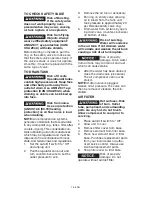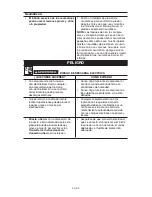
11 - ENG
Do not modify the plug provided. If
it does not fit the available outlet, a
correct outlet should be installed by
a qualified electrician.
Repairs to the cord set or plug
MUST be made by a qualified
electrician.
ExTENSION CORDS
If an extension cord must be used, be
sure it is:
•
a 3-wire extension cord that has
a 3-blade grounding plug, and a
3-slot receptacle that will accept
the plug on the product
• in good condition
• no longer than 50 feet (15.2 m)
•
12 gauge (AWG) or larger. (Wire
size increases as gauge number
decreases. 10 AWG and 8 AWG
may also be used. DO NOT USE
14 OR 16 AWG.)
The use of an
undersized extension
cord will cause voltage to drop
resulting in power loss to the motor
and overheating. Instead of using an
extension cord, increase the working
reach of the air hose by attaching
another length of hose to its end.
Attach additional lengths of hose as
needed. Always use an air hose rated
300 psi or greater.
VOLTAGE AND CIRCUIT
PROTECTION
Refer to the specification chart for the
voltage and minimum branch circuit
requirements.
Certain air
compressors can be
operated on a 15 amp circuit if the
following conditions are met.
1. Voltage supply to circuit must
comply with the National Electrical
Code.
2. Circuit is not used to supply any
other electrical needs.
3. Extension cords comply with
specifications.
4. Circuit is equipped with a 15 amp
circuit breaker or 15 amp time
delay fuse.
NOTE:
If compressor
is connected to a circuit protected
by fuses, use only time delay
fuses. Time delay fuses should be
marked "D" in Canada and "T" in
the US.
If any of the above conditions cannot
be met, or if operation of the compres-
sor repeatedly causes interruption
of the power, it may be necessary to
operate it from a 20 amp circuit. It is
not necessary to change the cord set.
TRANSPORTING
When transporting
the compressor in
a vehicle, trailer,
etc., make sure
the tank is drained
and the unit is
secured with
straps to prevent
tipping. Use care
when driving to
prevent tipping the
unit over in the vehicle. Damage can
occur to the compressor or
surrounding items if the compressor is
tipped.
Lifting
Always use two people when lift-
ing and lift from the recommended
lift points. DO NOT lift by wheels or
shroud.
Moving
The wheels and
handle do not
provide adequate clearance, stability,
or support for pulling the unit up and
down stairs or steps. The unit must be
lifted or pushed up a ramp.
1. Grasp handle of compressor and
tilt compressor back to rest on
wheels.
Risk of Unsafe
Operation. Ensure
proper footing and use caution
when rolling compressor so that
unit does not tip or cause loss of
balance.
2. When location is reached slowly
lower compressor to ground.
Always store compressor in a
vertical position
resting on the
rubber bumpers and wheels
.
Содержание 919.167551
Страница 21: ...21 NOTES NOTAS ...
Страница 41: ...45 NOTES NOTAS ...
Страница 42: ...46 NOTES NOTAS ...












































